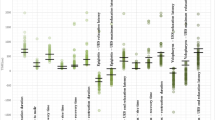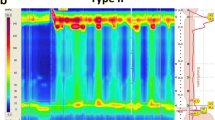Abstract
The lower esophageal high-pressure zone (HPZ) consists of the intrinsic lower esophageal sphincter (LES) and the diaphragmatic sphincter. In patients with a hiatal hernia these constituents are separated. We performed high-resolution manometry of the esophagogastric HPZ in six controls, six patients with a small hernia, and six patients with a large hernia. Prevalence of a double-peak pressure profile of the HPZ was noted. Pressures and distances between the peaks were assessed. Prevalence of the double-peak profile was similar between patients with a small hernia and controls, but patients with a large hernia showed a higher prevalence with inspiration (P<0.05) than the others. The distance between the two peaks was larger in patients with a large hernia (P<0.05). In conclusion, high-resolution manometry makes it possible to distinguish the diaphragmatic pressure component from the LES. Two pressure peaks can be found both in hernia patients and in healthy volunteers.
Similar content being viewed by others
REFERENCES
Mittal RK, Rochester DF, McCallum RW: Sphincteric action of the diaphragm during a relaxed lower esophageal sphincter in humans. Am J Physiol 256:G139–G144, 1989
Boyle JT, Altschuler SM, Nixon TE, Tuchman DN, Pack AI, Cohen S: Role of the diaphragm in the genesis of lower esophageal sphincter pressure in the cat. Gastroenterology 88:723–730, 1985
Sloan S, Rademaker AW, Kahrilas PJ: Determinants of gastroesophageal junction incompetence: Hiatal hernia, lower esophageal sphincter, or both? Ann Intern Med 117:977–982, 1992
Clark MD, Rinaldo JA Jr, Eyler WR: Correlation of manometric and radiologic data from the esophagogastric area. Radiology94:261–270, 1970
Dagradi AE, Stempien SJ: Symptomatic esophageal hiatus sliding hernia. Clinical, radiologic, and endoscopic study of 100 cases. Am J Digest Dis 7:613–633, 1962
Trujillo NP: Endoscopic diagnosis of sliding-type diaphragmatic hiatal hernias. Am J Digest Dis 13:855–867, 1968
Code CF, Kelley ML, Schlegel JF, Olsen AM: Detection of hiatal hernia during esophageal motility tests. Gastroenterology 43:521–531, 1962
Cuomo R, Sarnelli G, Grasso R, et al.: Manometric study of hiatal hernia and its correlation with esophageal peristalsis. Dig Dis Sci44:1747–1753, 1999
Omari T, Bakewell M, Fraser R, Malbert C, Davidson G, Dent J: Intraluminal micromanometry: An evaluation of the dynamic performance of microextrusions and sleeve sensors. Neurogastroenterol Motil8:241–245, 1996
Chen WH, Omari TI, Holloway RH, Checklin H, Dent J: A comparison of micromanometric and standard manometric techniques for recording of oesophageal motility. Neurogastroenterol Motil 10:253–262, 1998
Mittal RK: Hiatal hernia: Myth or reality? AmJ Med. 103:33S–39S, 1997
Schulze K, Dodds WJ, Christensen J, Wood JD: Esophageal manometry in the opossum. Am J Physiol 233:E152–E159, 1977
Klaus A, Raiser F, Swain JM, Hinder RA: Manometric components of the lower esophageal double hump. Dig Dis 18:172–177, 2000
Kasapidis P, Vassilakis JS, Tzovaras G, Chrysos E, Xynos E: Effect of hiatal hernia on esophageal manometry and pH-metry in gastroesophageal reflux disease. Dig Dis Sci 40:2724–2730, 1995
Kahrilas PJ, Lin S, Chen J, Manka M: The effect of hiatus hernia on gastro-oesophageal junction pressure. Gut 44:476–482, 1999
Bredenoord AJ, Weusten BL, Roelofs JM, Smout AJ: The gastrooesophageal pressure inversion point revisited. Scand J Gastroenterol 38:812–818, 2003
Lin S, Brasseur JG, Pouderoux P, Kahrilas PJ: The phrenic ampulla: distal esophagus or potential hiatal hernia?AmJ Physiol 268:G320–G327, 1995
Cuomo R, Grasso R, Sarnelli G et al.: Role of diaphragmatic crura and lower esophageal sphincter in gastroesophageal reflux disease: Manometric and pH-metric study of small hiatal hernia. Dig Dis Sci46:2687–2694, 2001
McCray WH, Jr., Chung C, Parkman HP, Miller LS: Use of simultaneous high-resolution endoluminal sonography (HRES) and manometry to characterize high pressure zone of distal esophagus. Dig Dis Sci 45:1660–1666, 2000
Winans CS: Alteration of lower esophageal sphincter characteristics with respiration and proximal esophageal balloon distention. Gastroenterology 62:380–388, 1972
Kahrilas PJ, Shi G, Manka M, Joehl RJ: Increased frequency of transient lower esophageal sphincter relaxation induced by gastric distention in reflux patients with hiatal hernia. Gastroenterology 118:688–695, 2000
Van Herwaarden MA, Samsom M, Smout AJ: Excess gastroesophageal reflux in patients with hiatus hernia is caused by mechanisms other than transient LES relaxations. Gastroenterology 119:1439–1446, 2000
Mattioli S, D'Ovidio F, Pilotti V et al.: Hiatus hernia and intrathoracic migration of esophagogastric junction in gastroesophageal reflux disease. Dig Dis Sci 48:1823–1831, 2003
Murray JA, Camilleri M: The fall and rise of the hiatal hernia. Gastroenterology 119:1779–1781, 2000
Author information
Authors and Affiliations
Corresponding author
Rights and permissions
About this article
Cite this article
Bredenoord, A.J., Weusten, B.L.A.M., Carmagnola, S. et al. Double-Peaked High-Pressure Zone at the Esophagogastric Junction in Controls and in Patients with a Hiatal Hernia: A Study Using High-Resolution Manometry. Dig Dis Sci 49, 1128–1135 (2004). https://doi.org/10.1023/B:DDAS.0000037799.29678.94
Issue Date:
DOI: https://doi.org/10.1023/B:DDAS.0000037799.29678.94




